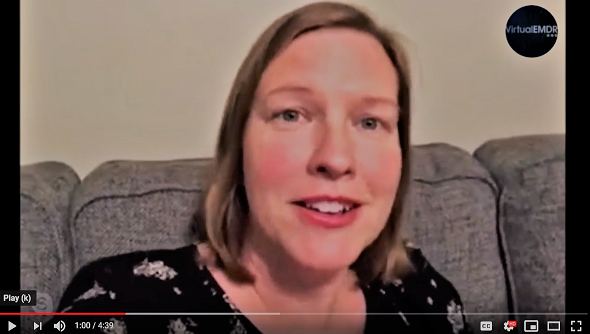VIRTUAL EMDR BLOG
How Should I Feel After My EMDR Session?
While everyone experiences EMDR differently – and even differently from session to session, here are three common emotions that come up after an EMDR session.
29 Apr 2021
![]() Tag:
Tag:

If you’re new to Eye Movement Desensitization and Reprocessing (EMDR), you may have heard people describe how they feel after their session – but their descriptions may be quite different:
- Some people describe feeling “tingly”, as if every molecule in their body has just awakened from a long sleep
- Other people describe feeling “lighter”, “calmer”, and “clearer”, and notice that objects around them seem brighter and sharper
- Yet others feel like they have been through an emotional roller coaster, experiencing heightened feelings that make them want to cry, scream, or laugh hysterically
- Some people also describe a sensation of a switch being flipped inside their brain, allowing it to work normally again. Or they may feel like EMDR helped them finally expunge the virus that was inside their brain, causing it to replay flashbacks of the trauma on endless loop.
The short answer is: Everyone’s experience after EMDR is different. In fact, it is not unusual for you to even experience different emotions after each session!
How EMDR works
To understand why this happens, let us first do a short recap of how EMDR works. You can also watch this 2-minute video:
When you experience trauma or stress, your brain goes into a survival or “fight-or-flight” mode. The “reptilian” part of the brain goes into overdrive, while the rational part of the brain (also known as the neocortex) shuts down to redirect focus and energy to the most essential functions necessary for immediate survival.
Because the neocortex shuts down, the normal processing of memories inside your brain is interrupted. This results in “unprocessed” memories, as well as distorted thoughts, which get trapped inside the brain. These intense emotions get repeatedly activated every time something reminds you of what happened (for example, triggered by certain images, sounds, or situations). Each time, you experience the same emotional rollercoaster.
In simple terms, EMDR replicates the normal functioning of the brain which was interrupted. You can finally process the stuck memories. You can also replace existing negative disempowering beliefs with new empowered beliefs.
For example, you may choose to replace an old self-belief of “I am a victim” with a powerful new belief such as “I am a survivor”. Or from “I will never feel happy again” to “I can control how I feel in future”.
Emotional Responses after EMDR
During your EMDR session, your nervous system (along with your brain) is repeatedly simulated. This is done through a moving visual object and/or audio tones, which is designed to stimulate both the left and right hemispheres of your brain.
This intense activation of your nervous system leads to different responses after your session, depending on what happened during the session and where you left things.
For example, here are three of the most common emotional responses experienced by clients after an EMDR session, and what they mean:
• Highly Emotional: Do you find yourself raging or in tears after a session? If so, that’s a good sign that your session has been successful. When your brain and nervous system responds to the issue you were focusing on, you are able to bring these emotions to the surface and express them. This manifests itself in a heightened emotional reaction.
• Peaceful and relaxed: Do you feel like you have moved past the issue you wanted to work on after a session? This is also a common response, especially if you took some time at the end to work through the breathing exercises. Some patients may find that feeling at peace is one of the most unambiguous responses to the success of a session.
• Numb: This is not necessarily a bad thing in itself. Sometimes, it can take your brain and nervous system a bit of time to process what happened during the session, which is completely normal. When you think about it, symptoms of PTSD and anxiety can also take some time to manifest themselves. You may experience intense, vivid dreams later on, an indication that your brain is processing it belatedly.
Regardless of how you feel after your session, most people (in fact, 9 in 10 of Virtual EMDR clients) report that they do feel less emotional distress compared to when they started. Even if you are feeling highly emotional, these emotions can be less distressing – since they are often a healthy release of pent-up emotions that have been trapped inside you for a long time.
Wherever you are, recognize that with each session, you are getting closer to resolving the unprocessed trauma and memories that led you to do EMDR. With time and continued regular practice, these memories can be un-stuck – allowing you to move past your current thoughts that are not serving you.
Virtual EMDR: Giving you the ability to do EMDR in the privacy of your home
Whether you are new to EMDR or have been applying it for a while, Virtual EMDR now gives you the ability to access this powerful therapy in the privacy of your home - through this online self-guided platform.
Tap the proven healing power of EMDR any time you feel triggered, night or day, as often as you need. No more scheduling or waiting for appointments, or wasting time traveling to a therapist’s office. Virtual EMDR is available to you from anywhere with an internet connection.
What’s more, you are guaranteed full anonymity – so you can get all the help that you need without fear or shame of others finding out.
With more than 10,000 satisfied customers, this expert-developed program is easy to use – even for absolute beginners. Choose the EMDR protocol that is most appropriate for each session – from the standard EMDR protocol used by many therapists, to unique customized programs for depression, anxiety, trauma, PTSD, and more.
"Thank you, Virtual EMDR, for making healing from trauma accessible (as it should be!). It took just minutes – and after that, I felt tingly, unburdened" -Kim Reck (Facebook)
LIMITED TIME OFFER: Use Promo code “HEALING10” for 10% off your first month of Virtual EMDR. Click here to start your free 3-day trial (www.virtualemdr.com/register)
Watch Jeff, Virtual EMDR's founder, talk about how you can tell if your EMDR session was successful:
Be the first to comment.
.png)









View Comments